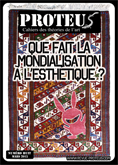Esthétique(s) contemporaine(s) et migration(s) postcoloniale(s)
Abstract
 Télécharger l’article
Télécharger l’article
Paru dans : Proteus n°8

L’article s’emploiera à montrer que l’arrivée de nouveaux venus dans les arts visuels contemporains bouleverse considérablement notre conception de l’universalité. Elle trouble également ce qu’on appellera le rapport cultivé du spectateur à l’art contemporain : les références supposées connues manquent en l’espèce de pertinence et transforment parfois le « spécialiste » en anthropologue ou en néophyte. La mondialisation postcoloniale a ceci d’intéressant, sur le plan esthétique, de placer le spectateur postcolonial (notamment français) face à l’étrangeté relative de pratiques artistiques. Il y a un risque à croire, contre l’hermétisme, en l’existence d’une compréhension immédiate : au pharmakon postcolonial. Cela ne révèle-t-il pas, au fond, combien, irréductiblement, les pratiques artistiques sont anomales ?
Mots-clés : art contemporain — postcolonial — imitation — créolisation
The aim of this article is to show that the arrival of newcomers in the world of contemporary visual arts is dramatically altering our conception of universality. It is also unsettling what we will call the viewer’s cultivated perspective on contemporary art: the supposedly known references are no longer as relevant in this context, and sometimes turn the "expert" into an anthropologist or a neophyte. The aesthetic interest of postcolonial globalization is that it confronts the postcolonial viewer (notably the French one) to the relative strangeness of artistic practices. Refusing hermetism and believing in the possibility of an immediate understanding — of a postcolonial pharmakon — is a risk. Doesn’t this reveal, ultimately, how radically anomalous artistic practices are?
Keywords : contemporary art — postcolonial — imitation — creolization








